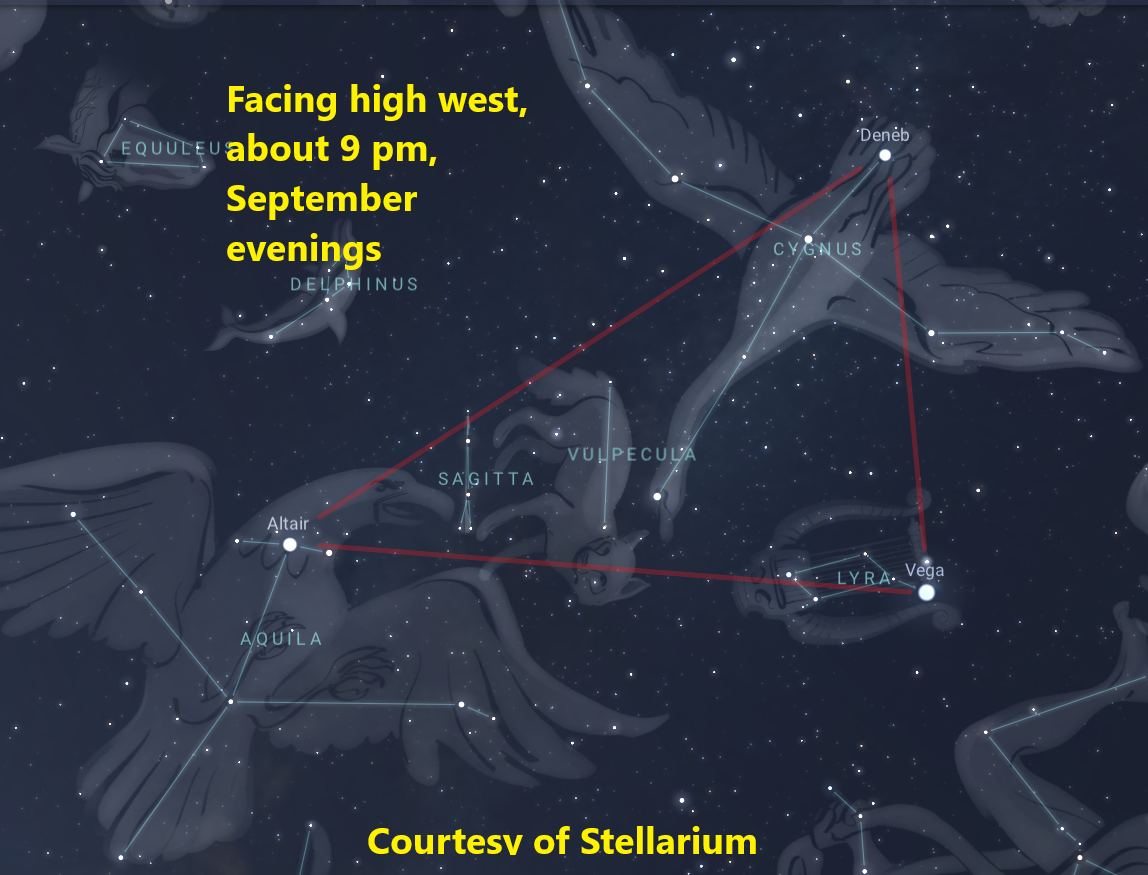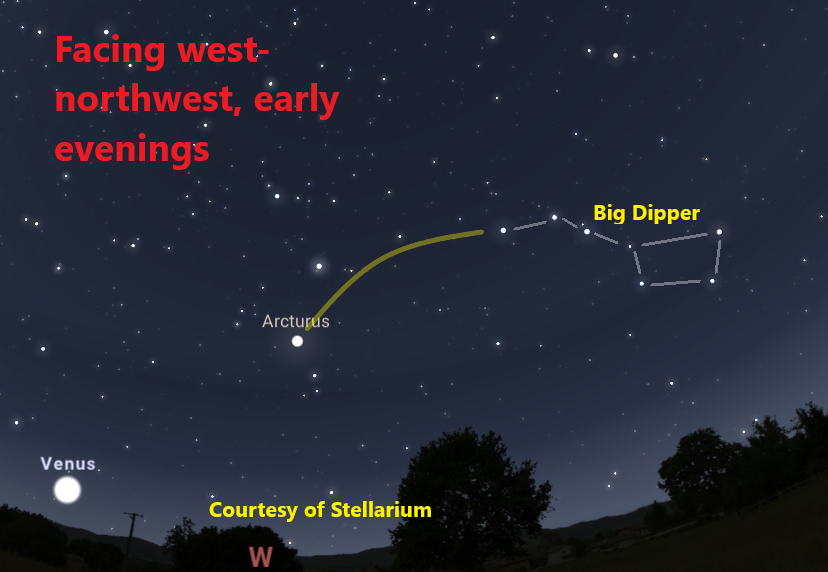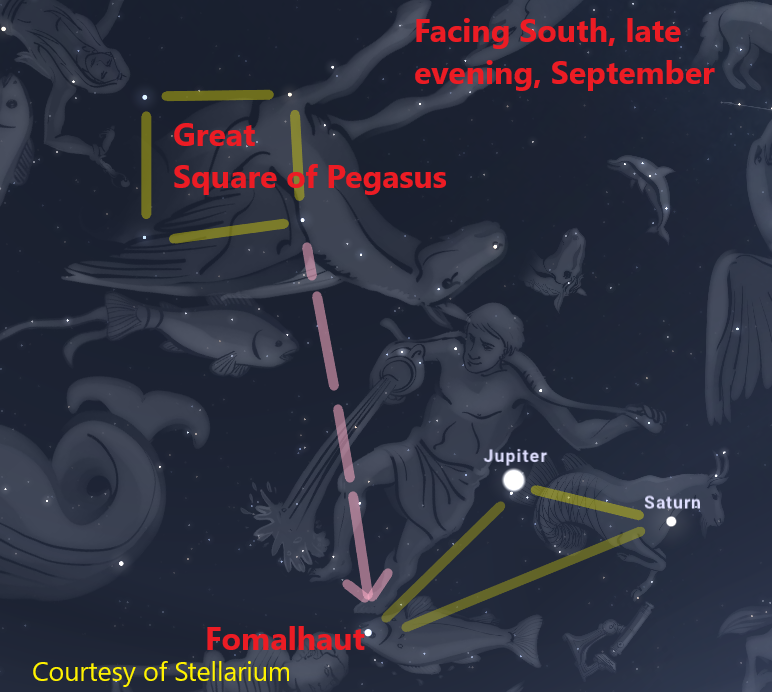FLYING INTO FALL

As I write this, the weather is still very much summer-like, with highs well up into the 90s, but you may have already noticed that the Sun is setting as much as 45 minutes earlier and rising 45 minutes later than it did a couple of months ago. Eventually, these shorter and shorter days will lead to milder temperatures, and some of the most comfortable times of the year to go outside will begin.
Excluding three planets, which I will discuss a little later, the most prominent landmark of the sky at this time of year is formed by three bright, what we call first magnitude stars, which form the huge Summer Triangle. Two of them pass practically overhead as seen from St. Louis and are currently seen high in the west in the late evening. Deneb, currently highest of all, marks the tail of the distinctive constellation of Cygnus, the Swan. It is possible to imagine a stick figure of a swan, or at least some sort of bird here, if your sky is dark enough, or even more easily, the Northern Cross. To the lower left is Altair, and with a bit more imagination, you can make out the figure of a soaring eagle, the constellation Aquila. Bring binoculars along to bring out some of the dimmer stars in the pattern, if your sky is brightly lit. The brightest of the three stars is Vega, the brightest member of the constellation Lyra, the harp- definitely not any sort of bird. However, to some of the aboriginal population of Australia, the stars of Lyra form the Malleefowl, a chicken-sized native bird that rarely if ever leaves the ground. On some ancient maps, the stars that form Lyra today were known as Vultur Cadens, the Falling Vulture.
Our three Summer Triangle stars actually form a great example of how things are not always as they appear to be in the sky. Just as the position of this page appears to change if you move your head from side to side, the position of nearby stars relative to distant ones appears to change if you measure their positions six months apart, using a baseline of half of Earth’s orbit, or about 186,000,000 miles. However, even the closest stars are so distant that only very accurate measurements can reveal this parallax, or change. Vega and Altair have been shown to be quite nearby by astronomical standards- 25 and 16 light years away, respectively. A light year is the distance that light travels in a year, at the speed of light of 186,300 miles per second. Multiply that times 60 seconds for a minute, times 60 minutes for an hour, times 24 hours for a day, and finally times 365 days for a year. This works out to be nearly 6,000,000,000,000 (trillion) miles. Efforts to measure Deneb’s parallax have come to grief because it is so far away that its parallax is infinitesimally small. Other, less accurate methods have been used to ballpark estimate the distance to Deneb as 2,600 light years. So the light from Deneb left around the time Ancient Rome was founded, near 500 B.C. Nevertheless, in spite of this immense distance, Deneb still shines as one of the first magnitude stars. This shows that it must be tremendously luminous, perhaps 100,000 times greater than our Sun. To put it another way, if you could move Deneb to Vega’s distance, it would shine as a point of light about as bright as a half moon in the sky!
As impressive as the stars of the Summer Triangle are, they are overshadowed by the three planets currently visible in the evening sky. Look low in the western to southwestern sky 30-60 minutes after sunset on September evenings to see brilliant Venus. Not quite as bright, but still outshining all actual stars, is Jupiter, in the southeast in the early evening. Due to its much greater distance from the Earth as well as receiving much less light from the Sun, Saturn appears to Jupiter’s right, as seen in the chart below- the second picture down. Due to its being about twice as distant from both Sun and Earth as Jupiter, Saturn appears much dimmer. Nevertheless, Saturn still outshines all non-planetary objects in the sky in the early evening except Vega high in the west, and Arcturus, low in the west to northwest. One way to identify Arcturus is to follow the arc of the Big Dipper’s handle to it, as can be seen here.


One last “flying” constellation that can be easily seen at this time of year is Pegasus, a mythological flying horse, which flies upside down high in the southern sky in the late evening at this time of year. The most prominent stars of Pegasus form the Great Square, a landmark of the sky. You can draw a line through the westernmost two stars in the square to find Fomalhaut, the last first magnitude star we will discuss this month. It is visible rather low in the southeastern sky on September evenings. No other bright stars usually shine anywhere near Fomalhaut in the sky, but it currently does have impressive company- in their current positions in their orbits, Jupiter and Saturn from a triangle with it.
Light Pollution can cause great harm, not just to stargazers but also to many forms of wildlife. Join us for our next Gateway to the Stars program on September 18 at 6:30 pm. “Lights Out Heartland,” an online discussion on how the Saint Louis Zoo, Dark Sky Missouri, and the National Park Service are working to mitigate light pollution. This program will be streamed via Facebook Live at www.facebook.com/stlastro. Weather permitting, volunteers from the St. Louis Astronomical Society will provide free telescope in person telescope viewing on the Arch West Entrance Plaza that same evening from 7:00-8:30 pm. Want to do both? Come to the live telescope viewing at the Arch and then see the video of the Lights Out program beginning the next day at the website above.
